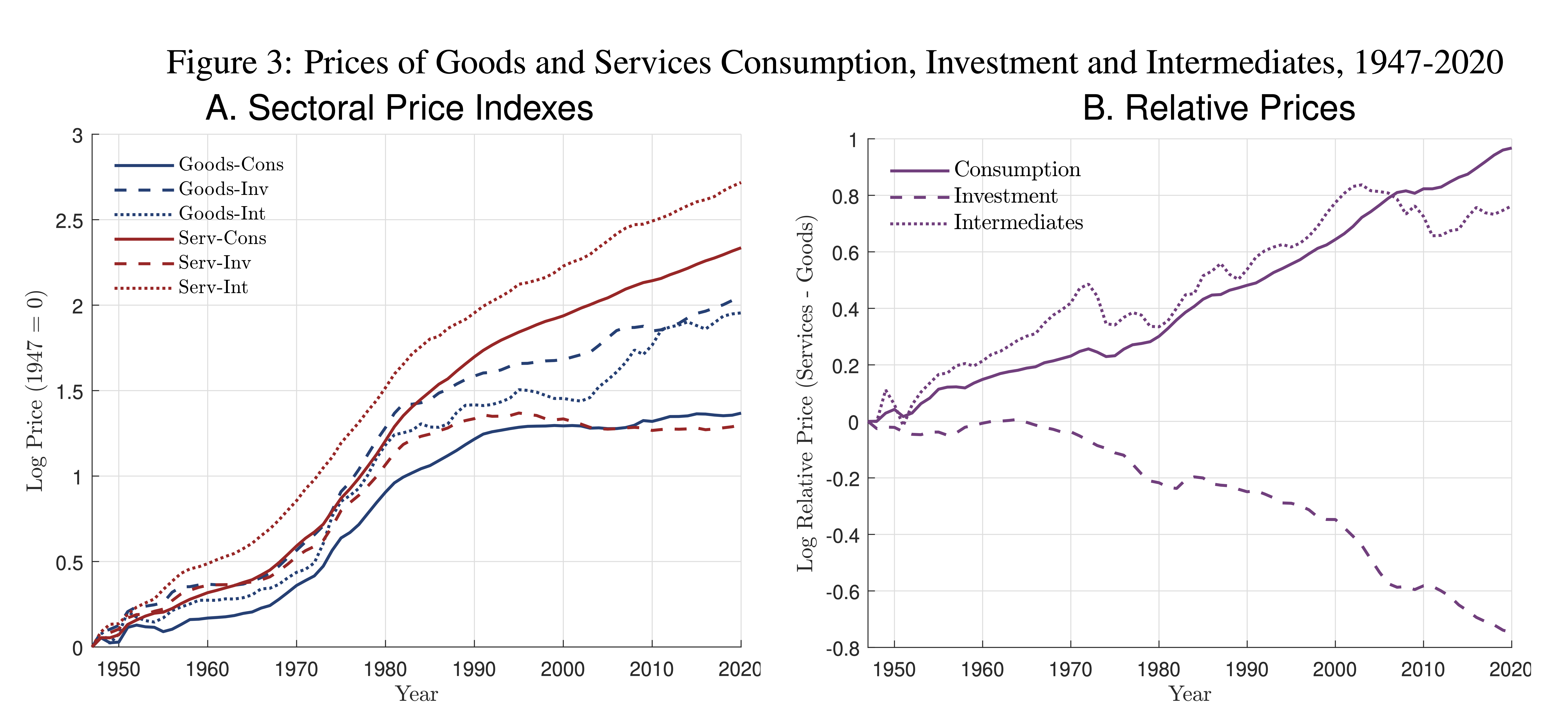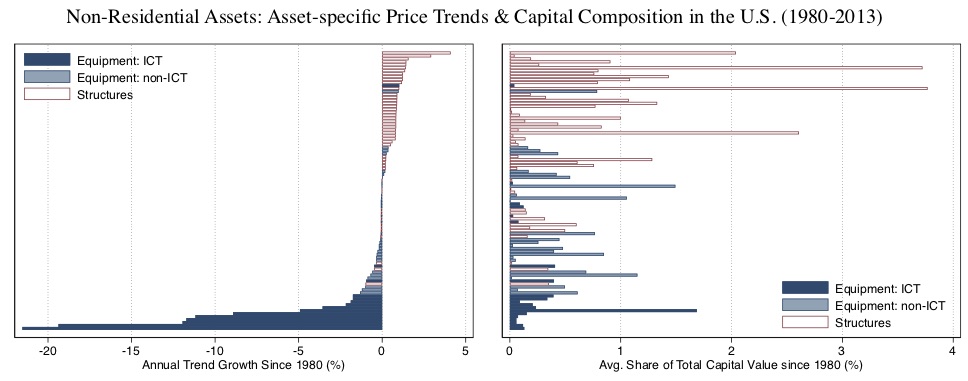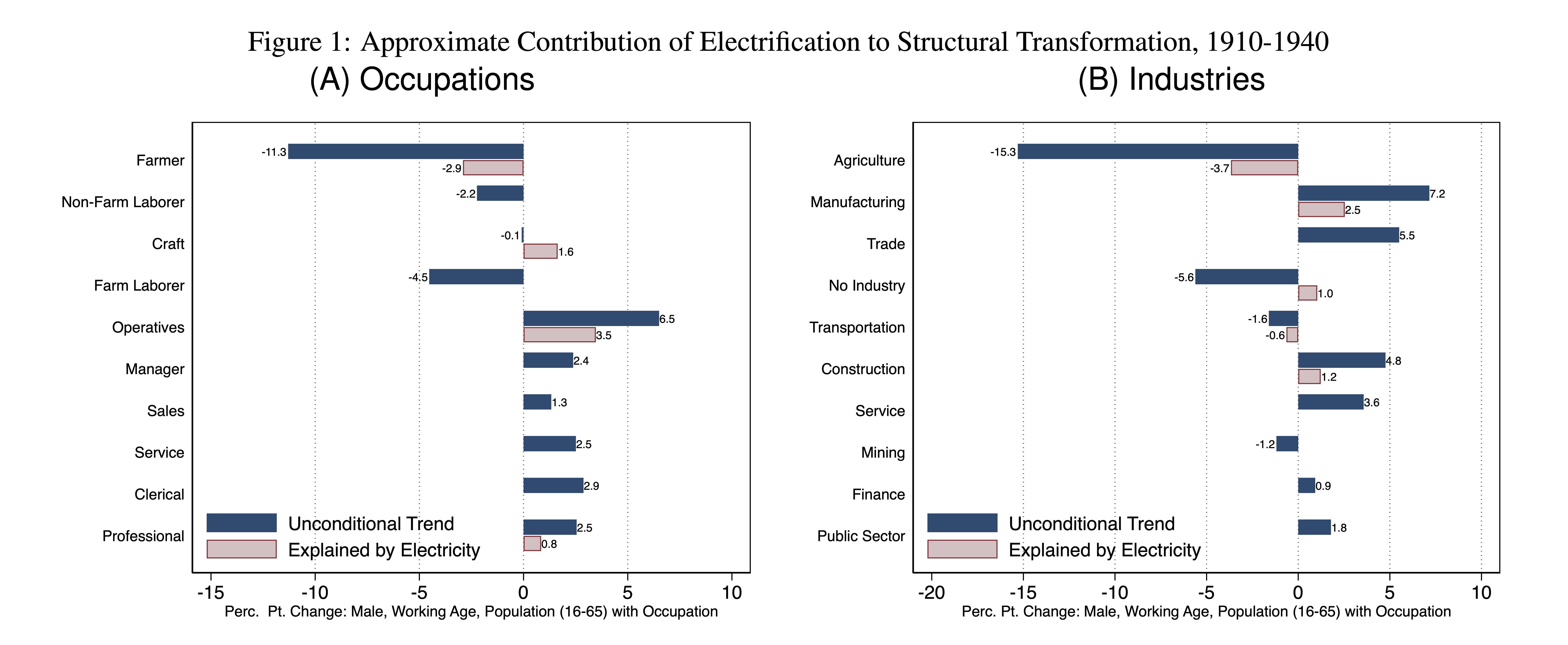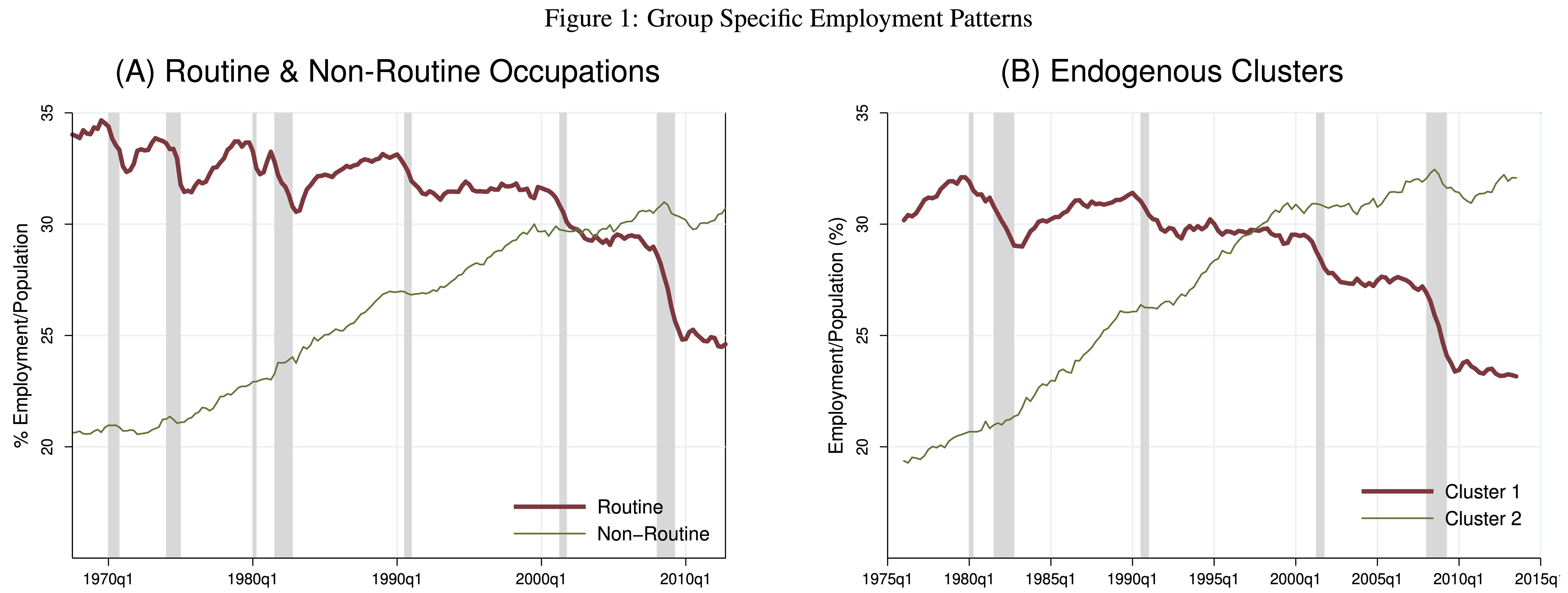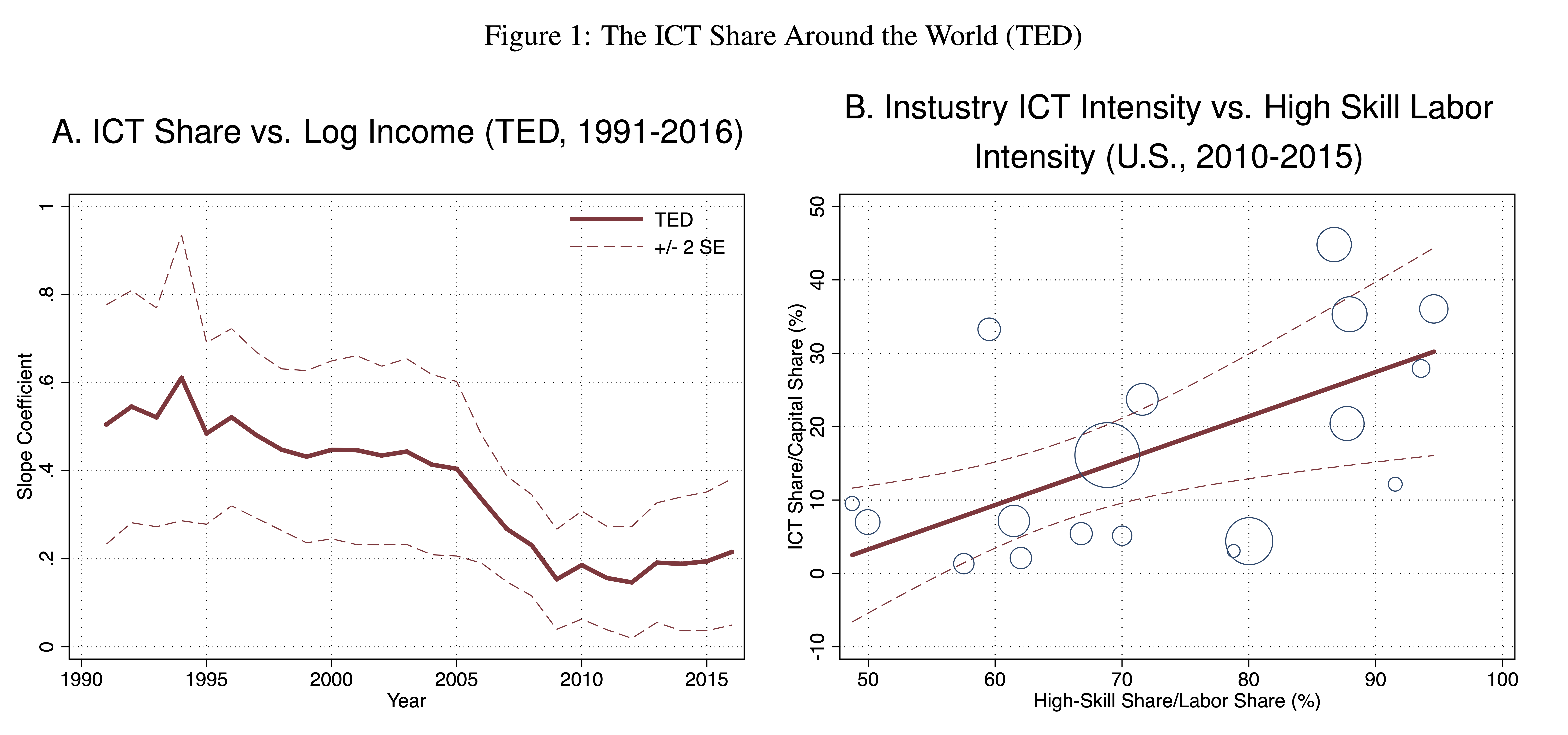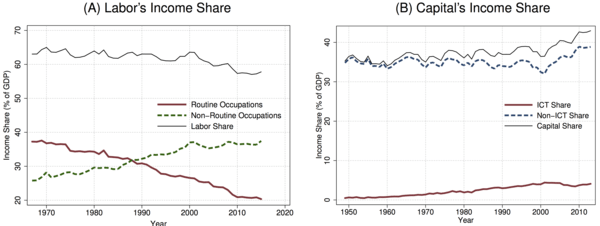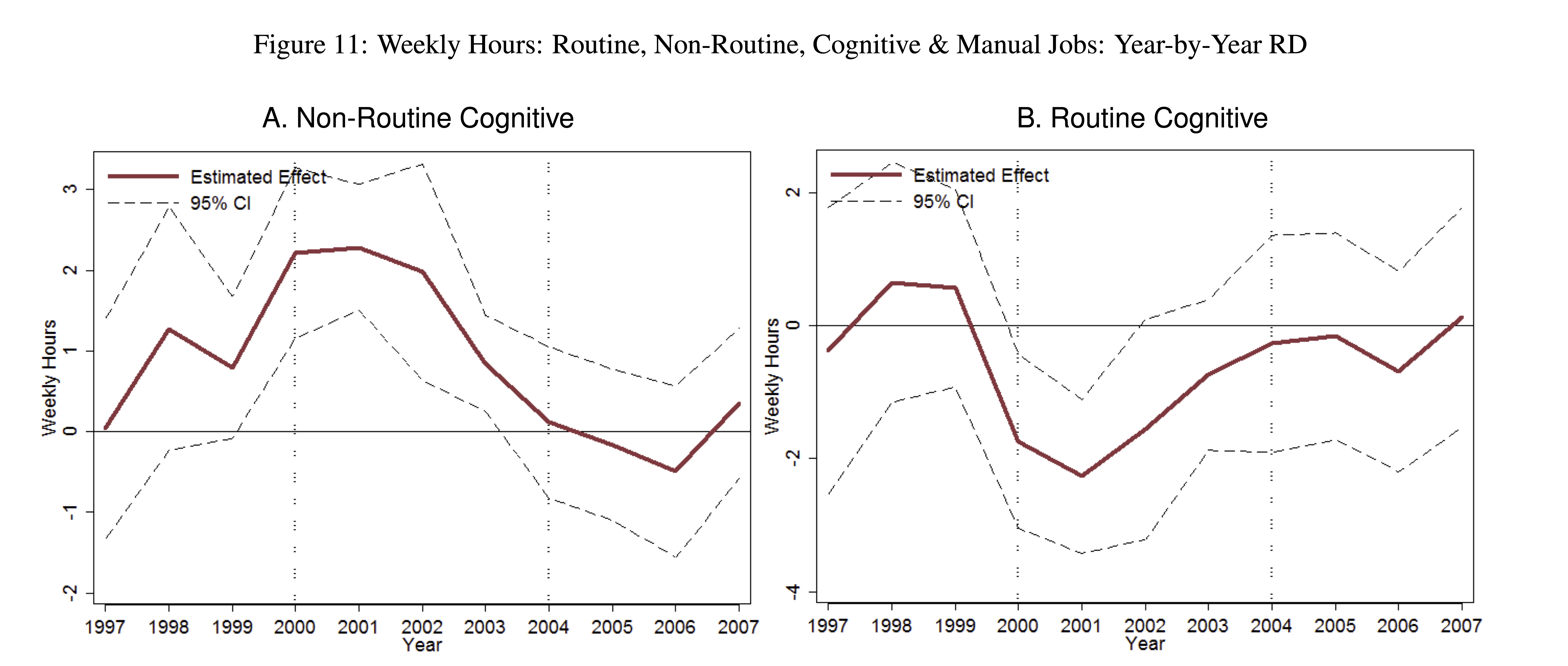Research
Conference Organization
I-85 Macroeconomics Workshop
Co-Founder and Co-Organizer with Toni Braun (GRIPS), Aspen Gorry (Clemson), Roozbeh Hosseini (UGA), and Juan Rubio-Ramirez (Emory)
The I-85 Macroeconomics Workshop is an effort to build ties between macroeconomics researchers in the Southeast and to expose graduate students pursuing a PhD in economics to macroeconomic research. We meet once a semester for one day, rotating between host institutions roughly along Interstate 85.
If you are interested in being added to the distribution list or would like to host, please email i85macro@gmail.com
Visit Conference WebsiteOngoing Projects (draft coming soon)

Firm-level heterogeneity in AI task demand changes by initial AI intensity. Click for higher resolution version with notes.
The Demand for Tasks in the Age of AI
I document emerging patterns in labor market task demand following ChatGPT's November 2022 launch, leveraging 48.3 million job postings (2022-2025) matched with Anthropic's classification of AI-suitable tasks from 3.5 million Claude conversations. Preliminary findings reveal a striking divergence: First, between May 2022 and May 2025 (only three years), we observe meaningful movements in demand for tasks in the labor market. Second, firms initially intensive in AI-suitable tasks (above median) substantively reduce their intensity in these tasks, while initially low-intensity firms (below median) do the opposite. Third, while the overall demand for AI-suitable tasks appears to have declined (on average), firms that increase the AI-intensity of their task demand do so primarily via tasks that Anthropic classifies as augmenting humans.
Innovation, Old and New Work: Evidence from the United States
with Rowena Gray, Ioana Marinescu, and Greg Wright
How do revolutionary technologies reshape what humans do at work? We examine how electrification transformed American workplace tasks during the early 20th century—potentially informing our understanding of today's AI revolution. We create a longitudinal task panel by combining newly digitized job descriptions from historical DOTs with linked Census records and digitized historical electricity grid maps. This enables granular task-level analysis beyond previous occupation-based studies, exploiting geographic variation in electricity access to identify causal effects. Prior work (including our own) shows electricity altered occupational distributions but cannot distinguish scenarios with identical occupational outcomes yet different worker impacts: (1) workers switching to new jobs while performing the same tasks, (2) workers staying in the same jobs but adopting new tasks, or (3) workforce replacement where some workers exit and others enter in different occupations. Distinguishing these scenarios is crucial because they can have vastly different implications for individual wellbeing and public policy.
AI Mentors for Entrepreneurs
with David Cooper, Arun Ravindran, and Krista Saral
This project investigates whether AI-powered mentoring systems can effectively substitute for scarce human mentorship in supporting artisan entrepreneurs. While human mentorship demonstrably improves entrepreneurial outcomes across multiple dimensions—from business strategy to operational efficiency—access remains severely limited, particularly for small-scale creative entrepreneurs operating on digital platforms. We are conducting a randomized controlled trial (RCT) that systematically varies exposure to AI-based mentoring and traditional human mentoring to establish causal evidence on three key questions: (1) Can AI systems deliver core mentoring functions including strategic advice, problem-solving support, and business planning guidance? (2) How does the effectiveness of AI mentoring compare to human mentoring across different entrepreneurial outcomes such as revenue growth, business sustainability, and operational improvements? (3) Do AI mentoring systems particularly benefit underserved entrepreneurs who traditionally lack access to business networks and mentorship? Our AI mentor employs Retrieval-Augmented Generation (RAG) technology built on Large Language Models, trained on successful business practices, platform-specific operational data, and insights from expert mentors. By rigorously evaluating whether scalable AI systems can provide meaningful mentorship functions, this research addresses fundamental questions about democratizing access to entrepreneurial support and the potential for AI to reduce inequalities in business development resources.
Working Papers
Structural Change in Production Networks and Economic Growth
with Aspen Gorry and Christian vom Lehn
second revision resubmitted to the Review of Economic Studies
September 2025 • CESifo Working Paper No. 10460
We study structural change in production networks for intermediate inputs (input-output network) and new capital (investment network). For each network, we document that the share of output produced by services (relative to goods) is rising over time. While the relative prices of services that produce intermediates and consumption are rising, we find that the relative price of services that produce investment is falling over time. We then develop a multi-sector growth model to study these trends and their implications for economic growth. To match the relative price trends, inputs to intermediates production are complements and inputs to investment production are substitutes. Hence, structural change endogenously reallocates resources to the slowest growing intermediates producers and the fastest growing investment producers. Growth accounting exercises reveal that investment-specific technical change accounts for an increasing share of U.S. aggregate growth, with 20% of aggregate growth since 2000 due to investment structural change. Growth projections from our model show that structural change within investment networks alone can offset stagnating or declining growth in other sectors due to Baumol's cost disease.
Capital Composition and the Declining Labor Share
with Maya Eden
November 2019 • CESifo Working Paper No. 7996
To what extent can technological advances in the production of capital account for the recent, worldwide decline in the labor income share? We pose two challenges to the automation narrative: first, estimates of the elasticity of substitution (EOS) between capital and labor tend to fall below or around one, suggesting that a decline in the price of capital should not lead to a decline in the labor income share. Second, we illustrate that, despite technological improvements, the price of capital relative to output has remained roughly constant, worldwide. This poses a challenge to the view that cheaper capital has caused the displacement of workers. We show that a more nuanced approach, which takes seriously the composition of capital, ascribes a prominent role to the automation hypothesis. Though information and communications (ICT) capital is a small fraction of the capital stock, it is highly substitutable with labor, and its user cost declined sharply over the last few decades. A framework that distinguishes between ICT and non-ICT capital is empirically plausible and suggests that automation accounts for more than one quarter of the global decline in the labor share, even if the aggregate EOS is substantially less than unity.
Recent Publications
Does Electricity Drive Structural Transformation? Evidence from the United States
with Rowena Gray, Ioana Marinescu, and Miguel Morin
Labour Economics, Volume 68, Pages 101944, October 2020
NBER Working Paper No. 26477
Electricity was the catalyst for the second industrial revolution in the early twentieth century. Developing countries are currently making huge investments in this general-purpose technology, with a view to achieving structural change. What can history teach us about its impact on the structure of employment? We use U.S. Census data and an identification strategy based on hydroelectric potential to identify the effects of the geographic expansion of higher-voltage electricity lines. We find that, over the period 1910–1940, electrification increased the share of operatives in the average county by 3.5 percentage points and decreased the share of farmers by 2.9 percentage points. These effects are primarily driven by rural electrification, and they can account for more than half of the aggregate increase in operatives, and more than one quarter of the total decrease in farmers. These results suggest that electrification was a key contributor to U.S. structural transformation.
The Cyclical Component of Labor Market Polarization and Jobless Recoveries in the US
with Sylvia Kaufmann
Journal of Monetary Economics, Volume 116, Pages 334-347, October 2019
Based on quarterly occupation-level data from the US Current Population Survey for 1976-2013, we exploit common cyclical employment dynamics to identify two clusters of occupations that roughly correspond to the widely discussed notion of 'routine' and 'non-routine' jobs. After decomposing the cyclical dynamics into a cluster-specific ('structural') and an occupation-specific ('idiosyncratic') component, we detect significant structural breaks in the systematic dynamics of both clusters around 1990. We show that, absent these breaks, employment in the three 'jobless recoveries' since 1990 would have recovered significantly more strongly than observed in the data, even after controlling for observed idiosyncratic shocks.
Do Poor Countries Really Need More IT?
with Maya Eden
World Bank Economic Review, Volume 33, Issue 1, Pages 48-62, July 2019
Productivity differences across countries are often attributed to differences in technological capabilities. This paper asks whether there are systematic cross-country differences in the adoption of Information Technologies (IT). We document that the degree of complementarity between IT and human capital is increasing in the complexity of production, and develop a quantitative framework in which this mechanism gives rise to endogenous cross-country differences in IT adoption. Using a matched firm/worker dataset from the UK as a laboratory to discipline our approach, we find that rich countries, which have more complex production, use IT more intensively. Quantitatively, we show that if US firms were to move to India, the proportion of IT workers in these firms would fall by 24%. However, these endogenous differences in IT usage are relatively modest. They account for roughly 7% of the overall per-capita income difference between the US and India.
Do Banks Take Unusual Risks When Interest Rates are Expected to Stay Low for a Long Time?
with Maria T. Valderrama
Macroeconomic Dynamics, Volume 23, Issue 6, Pages 2409-2433, September 2019
In this paper we address the question whether a low (short-term) interest rate environment as experienced in major economies over the recent past can lead to excessive risk taking by financial intermediaries. By using a simple partial equilibrium framework and a dataset on matched Austrian banks and firms over the period 2000-2008 we show that low interest rates induce banks to reduce the average rating of their new borrowers. We also find a significant effect on the monitoring effort exerted by the loan officer: low rates reduce the screening effort in the selection of new borrowers. Our analysis suggests that this period likely caused Austrian banks to hold riskier loan portfolios in response to cheaper short-term funds, than they would have in the absence of this policy.
On the Welfare Implications of Automation
with Maya Eden
Review of Economic Dynamics, Volume 29, Pages 15-43, July 2018
In this paper we ask whether the decline in the labor income share that has been witnessed in the United States and elsewhere over the past 30 years can be explained by automation. We emphasize two channels through which automation can reduce the labor income share. First, automation can be thought of as an extreme form of capital-skill complementarity: capital fully replaces tasks performed by low-skill workers, while high-skill workers are made more productive. Secondly, we endogenously determine the share of tasks that are automated, and show that under quite general conditions, there is a negative relationship between the cost of automation and the labor income share. We document that the decline in the labor income share over the recent decades has been particularly pronounced for low-skill workers -- a finding that is consistent with the view that automation has been an especially important driver of the labor income share decline. We also suggest that automation can explain why the decline in the labor income share has been accompanied by a decline in the relative price of investment goods. A representative agent framework suggests that automation led to a welfare gain, on average. However, these gains mask heterogeneity: automation can reduce low-skill wages in absolute terms, negatively affecting the welfare of low-skill workers.
A Short-Run View of What Computers Do: Evidence from a UK Tax Incentive
with Greg Wright
American Economic Journal: Applied Economics, Volume 9, Issue 3, Pages 262-294, July 2017
We study the short-run, causal effect of Information and Communication Technology (ICT) on the demand for (high- and low-skill) workers and on average skill upgrading. We exploit geographical variation in the eligibility for a program that encouraged UK establishments to adopt ICT. Areas subject to the program experienced a significant increase in ICT adoption, and we find that ICT adoption: (i) increases average hours worked and wages of workers in high-skill occupations; (ii) has a positive spillover effect on low-skill workers, who experience an increase in hours worked and hourly wages; (iii) increases within-establishment skill upgrading. We argue that our results are consistent with technology-skill complementarity models predicting larger productivity gains from ICT for high-skill workers, and with ICT decreasing communication/coordination costs, thereby increasing demand for all workers. However, by allowing firms to better monitor workers at intermediate levels of the organizational hierarchy, high-skill workers benefit more from ICT adoption. We find that the primary effect of ICT is to complement non-routine, cognitive-intensive work. The most ICT-intensive group of workers who benefit are managers and professionals in Business Service industries. There is also some evidence that, within low-skill occupations, ICT complements non-routine-intensive work.
Dormant Papers
The Impacts of Ending Long-Term Unemployment Insurance: Evidence from North Carolina
with Craig Depken
Revision requested by Economic Inquiry
(this version: 02-14-2016)
We investigate the causal effect of ending long-term emergency unemployment insurance (EUI) payments on labor market outcomes. Federal EUI payments in North Carolina (NC) expired on July 1, 2013, while EUI provision continued in all other states through December 31, 2013. We exploit cross-state variation generated by this unexpected NC law change to identify the causal effect of ending EUI payments. Our results indicate that the policy change induced a 1pp decrease in NC's unemployment rate, primarily due to unemployed individuals finding employment. However, these employment gains were concentrated in part-time jobs and among single females with children.
Did Banks Lend in Herds During 2000–2008?
with Maria T. Valderrama
Revision requested by Empirical Economics
(this version: 09-09-2013)
Systemic risk was one of the greatest concerns during the financial crisis of 2007/2008. But why did financial institutions choose asset portfolios that were highly correlated with their peers'? We seek to identify the degree to which financial institutions intentionally followed the actions of their competitors. Based on a matched bank-firm panel we construct three time varying measures of bank 'herding' within the Austrian business loan market for the period 2000-2008. These measures indicate sizable degrees to which banks were copying their peers' actions throughout the 2000s, particularly during the episode of low policy interest rates during 2003-2005.
Other Publications
The Impact of Education Earmarking on State Level Lottery Sales
joint with Carol O. Stivender, Louis H. Amato, and Tonya E. Farrow-Chestnut
The B.E. Journal of Economic Analysis and Policy, Volume 16, Issue 3, Pages 1473-1500, May 2016
Does a Low Interest Rate Environment Affect Risk Taking in Austria?
joint with Maria T. Valderrama
Monetary Policy & the Economy, Austrian Central Bank, Issue 4, Pages 32-48, December 2010
Will the Great Recession Lead to a Lasting Impact on Potential Output in Austria?
joint with Jürgen Janger
Monetary Policy & the Economy, Austrian Central Bank, Issue 3, Pages 26-52, November 2009
The Role of Exchange Rate Movements for Prices in the Euro Area
Monetary Policy & the Economy, Austrian Central Bank, Issue 2, Pages 83-103, August 2009
The Short and Long-run Interdependencies Between the Eurozone and the U.S.A.
joint with Serguei Kaniovski, Klaus Prettner, and Thomas Url
Empirica, Springer, Volume 36, Issue 2, Pages 209-227, May 2009
